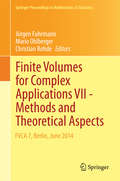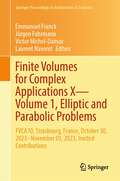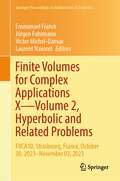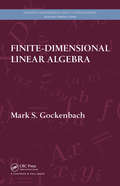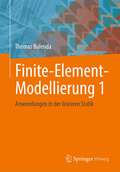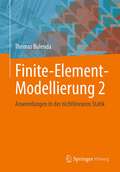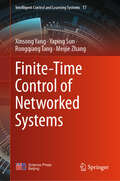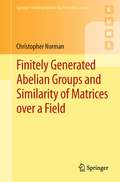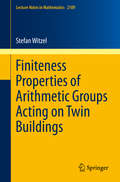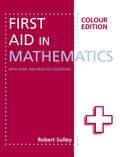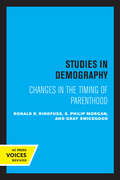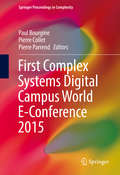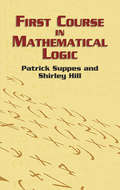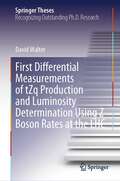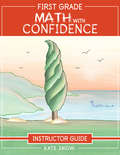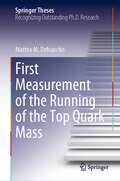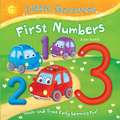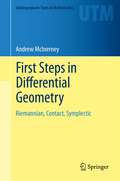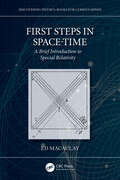- Table View
- List View
Finite Volumes for Complex Applications VII-Methods and Theoretical Aspects
by Jürgen Fuhrmann Mario Ohlberger Christian RohdeThe first volume of the proceedings of the 7th conference on "Finite Volumes for Complex Applications" (Berlin, June 2014) covers topics that include convergence and stability analysis, as well as investigations of these methods from the point of view of compatibility with physical principles. It collects together the focused invited papers, as well as the reviewed contributions from internationally leading researchers in the field of analysis of finite volume and related methods. Altogether, a rather comprehensive overview is given of the state of the art in the field. The finite volume method in its various forms is a space discretization technique for partial differential equations based on the fundamental physical principle of conservation. Recent decades have brought significant success in the theoretical understanding of the method. Many finite volume methods preserve further qualitative or asymptotic properties, including maximum principles, dissipativity, monotone decay of free energy, and asymptotic stability. Due to these properties, finite volume methods belong to the wider class of compatible discretization methods, which preserve qualitative properties of continuous problems at the discrete level. This structural approach to the discretization of partial differential equations becomes particularly important for multiphysics and multiscale applications. Researchers, PhD and masters level students in numerical analysis, scientific computing and related fields such as partial differential equations will find this volume useful, as will engineers working in numerical modeling and simulations.
Finite Volumes for Complex Applications X—Volume 1, Elliptic and Parabolic Problems: FVCA10, Strasbourg, France, October 30, 2023–November 03, 2023, Invited Contributions (Springer Proceedings in Mathematics & Statistics #432)
by Jürgen Fuhrmann Emmanuel Franck Victor Michel-Dansac Laurent NavoretThis volume comprises the first part of the proceedings of the 10th International Conference on Finite Volumes for Complex Applications, FVCA, held in Strasbourg, France, during October 30 to November 3, 2023.The Finite Volume method, and several of its variants, is a spatial discretization technique for partial differential equations based on the fundamental physical principle of conservation. Recent decades have brought significant success in the theoretical understanding of the method. Many finite volume methods are also built to preserve some properties of the continuous equations, including maximum principles, dissipativity, monotone decay of the free energy, asymptotic stability, or stationary solutions. Due to these properties, finite volume methods belong to the wider class of compatible discretization methods, which preserve qualitative properties of continuous problems at the discrete level. This structural approach to the discretization of partial differential equations becomes particularly important for multiphysics and multiscale applications. In recent years, the efficient implementation of these methods in numerical software packages, more specifically to be used in supercomputers, has drawn some attention. This volume contains all invited papers, as well as the contributed papers focusing on finite volume schemes for elliptic and parabolic problems. They include structure-preserving schemes, convergence proofs, and error estimates for problems governed by elliptic and parabolic partial differential equations. The second volume is focused on finite volume methods for hyperbolic and related problems, such as methods compatible with the low Mach number limit or able to exactly preserve steady solutions, the development and analysis of high order methods, or the discretization of kinetic equations.
Finite Volumes for Complex Applications X—Volume 2, Hyperbolic and Related Problems: FVCA10, Strasbourg, France, October 30, 2023–November 03, 2023 (Springer Proceedings in Mathematics & Statistics #433)
by Jürgen Fuhrmann Emmanuel Franck Victor Michel-Dansac Laurent NavoretThis volume comprises the second part of the proceedings of the 10th International Conference on Finite Volumes for Complex Applications, FVCA, held in Strasbourg, France, during October 30 to November 3, 2023.The Finite Volume method, and several of its variants, is a spatial discretization technique for partial differential equations based on the fundamental physical principle of conservation. Recent decades have brought significant success in the theoretical understanding of the method. Many finite volume methods are also built to preserve some properties of the continuous equations, including maximum principles, dissipativity, monotone decay of the free energy, asymptotic stability, or stationary solutions. Due to these properties, finite volume methods belong to the wider class of compatible discretization methods, which preserve qualitative properties of continuous problems at the discrete level. This structural approach to the discretization of partial differential equations becomes particularly important for multiphysics and multiscale applications. In recent years, the efficient implementation of these methods in numerical software packages, more specifically to be used in supercomputers, has drawn some attention. The first volume contains all invited papers, as well as the contributed papers focusing on finite volume schemes for elliptic and parabolic problems. They include structure-preserving schemes, convergence proofs, and error estimates for problems governed by elliptic and parabolic partial differential equations.This volume is focused on finite volume methods for hyperbolic and related problems, such as methods compatible with the low Mach number limit or able to exactly preserve steady solutions, the development and analysis of high order methods, or the discretization of kinetic equations.
Finite and Boundary Element Tearing and Interconnecting Solvers for Multiscale Problems
by Clemens PechsteinTearing and interconnecting methods, such as FETI, FETI-DP, BETI, etc., are among the most successful domain decomposition solvers for partial differential equations. The purpose of this book is to give a detailed and self-contained presentation of these methods, including the corresponding algorithms as well as a rigorous convergence theory. In particular, two issues are addressed that have not been covered in any monograph yet: the coupling of finite and boundary elements within the tearing and interconnecting framework including exterior problems, and the case of highly varying (multiscale) coefficients not resolved by the subdomain partitioning. In this context, the book offers a detailed view to an active and up-to-date area of research.
Finite or Infinite Dimensional Complex Analysis: Proceedings Of The Seventh International Colloquium (Lecture Notes in Pure and Applied Mathematics #Vol. 214)
by Zhong Li Joji Kajiwara Kwang Ho ShonThis volume presents the proceedings of the Seventh International Colloquium on Finite or Infinite Dimensional Complex Analysis held in Fukuoka, Japan. The contributions offer multiple perspectives and numerous research examples on complex variables, Clifford algebra variables, hyperfunctions and numerical analysis.
Finite-Dimensional Linear Algebra (Discrete Mathematics and Its Applications)
by Mark S. GockenbachThis text provides a solid foundation for the study of advanced mathematics and covers many interesting applications of linear algebra, which show how linear algebra is essential in such diverse areas as combinatorics, differential equations, optimization, and approximation. The book discusses important concepts and methods from numerical linear algebra and contains a range of exercises in each section, including some that can be solved using a computer package such as MATLAB. It also incorporates mini-projects that encourage students to develop topics not covered in the text. A forthcoming solutions manual is available for qualifying instructors.
Finite-Dimensional Vector Spaces: Second Edition (Dover Books on Mathematics #7)
by Paul R. HalmosA fine example of a great mathematician's intellect and mathematical style, this classic on linear algebra is widely cited in the literature. The treatment is an ideal supplement to many traditional linear algebra texts and is accessible to undergraduates with some background in algebra. "This is a classic but still useful introduction to modern linear algebra. It is primarily about linear transformations … It's also extremely well-written and logical, with short and elegant proofs. … The exercises are very good, and are a mixture of proof questions and concrete examples. The book ends with a few applications to analysis … and a brief summary of what is needed to extend this theory to Hilbert spaces." — Allen Stenger, MAA Reviews, maa.org, May, 2016."The theory is systematically developed by the axiomatic method that has, since von Neumann, dominated the general approach to linear functional analysis and that achieves here a high degree of lucidity and clarity. The presentation is never awkward or dry, as it sometimes is in other 'modern' textbooks; it is as unconventional as one has come to expect from the author. The book contains about 350 well-placed and instructive problems, which cover a considerable part of the subject. All in all this is an excellent work, of equally high value for both student and teacher." — Zentralblatt für Mathematik.
Finite-Element-Modellierung 1: Anwendungen in der linearen Statik
by Thomas BulendaEs gibt eine Vielzahl von „Wie-erstelle-ich-ein Finite-Element-Programm?“-Lehrbüchern, aber nur recht wenige Veröffentlichungen zur Frage „Wie wende ich ein Finite-Element-Programm an?“. Dieses Buch legt den Schwerpunkt auf die zweite Fragestellung. Es basiert auf den Vorlesungen zur Anwendung der Finite-Element-Methode, die der Autor seit 1998 an der OTH Regensburg hält. Deren Inhalte kommen aus seiner Tätigkeit als Prüfingenieur für Baustatik in einem großen Münchener Ingenieurbüro. Behandelt werden sowohl Fragestellungen, mit denen sich jeder Ingenieur konfrontiert sieht, wenn er Berechnungen mit einem Finite-Element-Programm erstellen will, als auch Problempunkte, die im Büro des Autors im Zuge einer Projektbearbeitung auftraten und auf den ersten Blick gar nicht so klar waren. In Teil 1 des zweibändigen Werks werden Themen aus der linearen Statik behandelt.
Finite-Element-Modellierung 2: Anwendungen in der nichtlinearen Statik
by Thomas BulendaEs gibt eine Vielzahl von „Wie-erstelle-ich-ein Finite-Element-Programm?“-Lehrbüchern, aber nur recht wenige Veröffentlichungen zur Frage „Wie wende ich ein Finite-Element-Programm an?“. Dieses Buch legt den Schwerpunkt auf die zweite Fragestellung. Es basiert auf den Vorlesungen zur Anwendung der Finite-Element-Methode, die der Autor seit 1998 an der OTH Regensburg hält. Deren Inhalte kommen aus seiner Tätigkeit als Prüfingenieur für Baustatik in einem großen Münchener Ingenieurbüro. Behandelt werden sowohl Fragestellungen, mit denen sich jeder Ingenieur konfrontiert sieht, wenn er Berechnungen mit einem Finite-Element-Programm erstellen will, als auch Problempunkte, die im Büro des Autors im Zuge einer Projektbearbeitung auftraten und auf den ersten Blick gar nicht so klar waren. Der 2.Teil des zweibändigen Werkes befasst sich mit Themen aus der nichtlinearen Statik.
Finite-Time Control of Networked Systems (Intelligent Control and Learning Systems #17)
by Xinsong Yang Yaping Sun Rongqiang Tang Meijie ZhangThis book mainly provides recent advances in finite-time and fixed-time control issues for complex networks and neural networks. It is well known that finite-time techniques have more advantages over asymptotical ones. Besides fast convergence rates, finite-time techniques have better robustness and disturbance rejection properties. However, it is challenging to deal with time delay in studying finite-time control. For readers’ easy understanding, the finite-time control issue for systems with and without time delays is separately introduced in this book. Moreover, the issues of finite-time and fixed-time control for differential equations with discontinuous states on the right-hand side are also considered. Many interesting results concerning finite-time and fixed-time synchronization are provided in the form of lemmas, theorems, or corollaries, accompanied by systematic theoretical analysis for the proof of their sufficient conditions, controller design, and new analysis techniques. Each new result is verified by at least one numerical example with detailed data analysis. Therefore, this book is an advantageous tool and is beneficial for interested experts and scholars in the control field.
Finitely Generated Abelian Groups and Similarity of Matrices over a Field
by Christopher NormanAt first sight, finitely generated abelian groups and canonical forms of matrices appear to have little in common. However, reduction to Smith normal form, named after its originator H.J.S.Smith in 1861, is a matrix version of the Euclidean algorithm and is exactly what the theory requires in both cases. Starting with matrices over the integers, Part 1 of this book provides a measured introduction to such groups: two finitely generated abelian groups are isomorphic if and only if their invariant factor sequences are identical. The analogous theory of matrix similarity over a field is then developed in Part 2 starting with matrices having polynomial entries: two matrices over a field are similar if and only if their rational canonical forms are equal. Under certain conditions each matrix is similar to a diagonal or nearly diagonal matrix, namely its Jordan form. The reader is assumed to be familiar with the elementary properties of rings and fields. Also a knowledge of abstract linear algebra including vector spaces, linear mappings, matrices, bases and dimension is essential, although much of the theory is covered in the text but from a more general standpoint: the role of vector spaces is widened to modules over commutative rings. Based on a lecture course taught by the author for nearly thirty years, the book emphasises algorithmic techniques and features numerous worked examples and exercises with solutions. The early chapters form an ideal second course in algebra for second and third year undergraduates. The later chapters, which cover closely related topics, e.g. field extensions, endomorphism rings, automorphism groups, and variants of the canonical forms, will appeal to more advanced students. The book is a bridge between linear and abstract algebra.
Finiteness Properties of Arithmetic Groups Acting on Twin Buildings
by Stefan WitzelProviding an accessible approach to a special case of the Rank Theorem, the present text considers the exact finiteness properties of S-arithmetic subgroups of split reductive groups in positive characteristic when S contains only two places. While the proof of the general Rank Theorem uses an involved reduction theory due to Harder, by imposing the restrictions that the group is split and that S has only two places, one can instead make use of the theory of twin buildings.
Fintech with Artificial Intelligence, Big Data, and Blockchain (Blockchain Technologies)
by Paul Moon Sub Choi Seth H. HuangThis book introduces readers to recent advancements in financial technologies. The contents cover some of the state-of-the-art fields in financial technology, practice, and research associated with artificial intelligence, big data, and blockchain—all of which are transforming the nature of how products and services are designed and delivered, making less adaptable institutions fast become obsolete. The book provides the fundamental framework, research insights, and empirical evidence in the efficacy of these new technologies, employing practical and academic approaches to help professionals and academics reach innovative solutions and grow competitive strengths.
First Aid in Mathematics Colour Edition
by Robert SulleyAchieve the best possible standard with this bestselling book of traditional practice and guidance - now in colour! First Aid in Mathematics provides all the help and support needed for learning and practising Mathematics. It offers comprehensive coverage of core mathematical topics in clear and accessible language. It is suitable for both native English speakers and students of English as a second language and can be used in class, or as a reference and revision book. - Develops a strong basis of understanding with core topics covered in clear and accessible language - Improves student's ability to work through problems with plenty of practice exercises and revision tests - Reflects its international readership with terms and information that are appropriate for students worldwide
First Aid in Mathematics Colour Edition
by Robert SulleyAchieve the best possible standard with this bestselling book of practice and guidance - now in colour First Aid in Mathematics is written in clear and concise language to provide all the help, support and practice needed to master the key topics in basic mathematics. The book contains over 1,000 carefully planned practice questions to help readers reinforce their knowledge. Revision tests are provided at the end of each chapter. First Aid in Mathematics is ideal for use in the classroom or as a reference and revision book for those wanting to improve their mathematical skills.
First Births in America: Changes in the Timing of Parenthood (Studies in Demography #2)
by S. Philip Morgan Ronald R. Rindfuss C Gray SwicegoodThis title is part of UC Press's Voices Revived program, which commemorates University of California Press’s mission to seek out and cultivate the brightest minds and give them voice, reach, and impact. Drawing on a backlist dating to 1893, Voices Revived makes high-quality, peer-reviewed scholarship accessible once again using print-on-demand technology. This title was originally published in 1988.
First Complex Systems Digital Campus World E-Conference 2015
by Pierre Collet Paul Bourgine Pierre ParrendThis book contains the proceedings as well as invited papers for the first annual conference of the UNESCO Unitwin Complex System Digital Campus (CSDC), which is an international initiative gathering 120 Universities on four continents, and structured in ten E-Departments. First Complex Systems Digital Campus World E-Conference 2015 features chapters from the latest research results on theoretical questions of complex systems and their experimental domains. The content contained bridges the gap between the individual and the collective within complex systems science and new integrative sciences on topics such as: genes to organisms to ecosystems, atoms to materials to products, and digital media to the Internet. The conference breaks new ground through a dedicated video-conferencing system - a concept at the heart of the international UNESCO UniTwin, embracing scientists from low-income and distant countries. This book promotes an integrated system of research, education, and training. It also aims at contributing to global development by taking into account its social, economic, and cultural dimensions. First Complex Systems Digital Campus World E-Conference 2015 will appeal to students and researchers working in the fields of complex systems, statistical physics, computational intelligence, and biological physics.
First Course in Mathematical Logic (Dover Books on Mathematics)
by Patrick Suppes Shirley HillIn modern mathematics, both the theory of proof and the derivation of theorems from axioms bear an unquestioned importance. The necessary skills behind these methods, however, are frequently underdeveloped. This book counters that neglect with a rigorous introduction that is simple enough in presentation and context to permit relatively easy comprehension. It comprises the sentential theory of inference, inference with universal quantifiers, and applications of the theory of inference developed to the elementary theory of commutative groups. Throughout the book, the authors emphasize the pervasive and important problem of translating English sentences into logical or mathematical symbolism. Their clear and coherent style of writing ensures that this work may be used by students in a wide range of ages and abilities.
First Differential Measurements of tZq Production and Luminosity Determination Using Z Boson Rates at the LHC (Springer Theses)
by David WalterThis thesis describes two groundbreaking measurements in the precision frontier at the LHC: the first ever differential measurement of the Z-associated single top quark (tZq) production, and the luminosity measurement using Z boson production rate for the first time in CMS. Observed only in 2018, the tZq process is of great importance in probing top quark electroweak couplings. These couplings are natural places for new phenomena to happen in the top quark sector of the standard model. Yet, they are the least explored directly. One has to obtain a firm understanding of the modeling of sensitive distributions to new top-Z interactions. The present analysis marks a major milestone in this long-term effort. All distributions relevant for new phenomena, and/or modeling of tZq, are studied in full depth using advanced Machine Learning techniques.The luminosity and its uncertainty contributes to every physics result of the experiment. The method minutely developed in this thesis provides a complementary measurement that results in a significant overall reduction of uncertainties.
First Grade Math with Confidence Instructor Guide (Math with Confidence #5)
by Kate SnowEasy-to-use, comprehensive coverage of all essential first grade math topics. This scripted, open-and-go program from math educator Kate Snow will give you the tools you need to teach math with confidence—even if you’ve never taught math before. Short, engaging, and hands-on lessons will help your child develop a strong understanding of math, step by step. Counting, comparing, and writing numbers to 100 Addition and subtraction facts to 20 Addition and subtraction word problems Beginning place-value and mental math Shapes, money, time, and measurement
First Hitting Time Regression Models: Lifetime Data Analysis Based on Underlying Stochastic Processes
by Chrysseis CaroniThis book aims to promote regression methods for analyzing lifetime (or time-to-event) data that are based on a representation of the underlying process, and are therefore likely to offer greater scientific insight compared to purely empirical methods. In contrast to the rich statistical literature, the regression methods actually employed in lifetime data analysis are limited, particularly in the biomedical field where D. R. Cox’s famous semi-parametric proportional hazards model predominates. Practitioners should become familiar with more flexible models. The first hitting time regression models (or threshold regression) presented here represent observed events as the outcome of an underlying stochastic process. One example is death occurring when the patient’s health status falls to zero, but the idea has wide applicability – in biology, engineering, banking and finance, and elsewhere. The central topic is the model based on an underlying Wiener process, leading to lifetimes following the inverse Gaussian distribution. Introducing time-varying covariates and many other extensions are considered. Various applications are presented in detail.
First Measurement of the Running of the Top Quark Mass (Springer Theses)
by Matteo M. DefranchisIn this thesis, the first measurement of the running of the top quark mass is presented. This is a fundamental quantum effect that had never been studied before. Any deviation from the expected behaviour can be interpreted as a hint of the presence of physics beyond the Standard Model. All relevant aspects of the analysis are extensively described and documented. This thesis also describes a simultaneous measurement of the inclusive top quark-antiquark production cross section and the top quark mass in the simulation. The measured cross section is also used to precisely determine the values of the top quark mass and the strong coupling constant by comparing to state-of-the-art theoretical predictions. All the theoretical and experimental aspects relevant to the results presented in this thesis are discussed in the initial chapters in a concise but complete way, which makes the material accessible to a wider audience.
First Numbers: Touch-and-Trace Early Learning Fun! (Little Groovers)
by Angie HewittPresenting a fun and engaging way to introduce early learning concepts to young children! Kids can use their finger to follow the grooves on each page to learn numbers 1-10. They can practice their numbers by tracing the grooves with their fingers from one snail all the way up to ten leaping frogs.The Little Groovers series is an excellent way for children to:Develop hand-eye coordinationEncourage motor skills developmentBoost learning through interactive playFirst Numbers is an engaging and colorful way to introduce early concepts to toddlers. Practice again and again with this new board book series to get children ready for preschool and prewriting.
First Steps in Differential Geometry: Riemannian, Contact, Symplectic
by Andrew McinerneyDifferential geometry arguably offers the smoothest transition from the standard university mathematics sequence of the first four semesters in calculus, linear algebra, and differential equations to the higher levels of abstraction and proof encountered at the upper division by mathematics majors. Today it is possible to describe differential geometry as "the study of structures on the tangent space," and this text develops this point of view. This book, unlike other introductory texts in differential geometry, develops the architecture necessary to introduce symplectic and contact geometry alongside its Riemannian cousin. The main goal of this book is to bring the undergraduate student who already has a solid foundation in the standard mathematics curriculum into contact with the beauty of higher mathematics. In particular, the presentation here emphasizes the consequences of a definition and the careful use of examples and constructions in order to explore those consequences.
First Steps in Space-Time: A Brief Introduction to Special Relativity (Discovering Physics)
by Ed MacaulayFirst Steps in Space-Time: A Brief Introduction to Special Relativity provides an accessible, authentic, and readable introduction to the theory of special relativity. The academic level of the book builds only on skills that would be covered in a GCSE maths course, such as Pythagoras's theorem, and rearranging equations, and no prior knowledge of relativity (or physics) is assumed. The key benefits of the work are to bridge the gap between popular science books and university textbooks, and make the theory of relativity as broadly accessible as physically possible. The book allows the reader to discover and appreciate that relativity is not an intractable esoteric curiosity, but a beautiful and succinct theory that profoundly shaped the course of history and our interpretation of our day-to-day lives. This book is ideal for readers with an interest in physics and a little working knowledge of maths, who have studied mathematics at about A-level standard: professionals such as accountants, bankers, doctors, economists, engineers, lawyers, pharmacists and teachers, or high school students who might be considering studying physics or a related subject at university.
